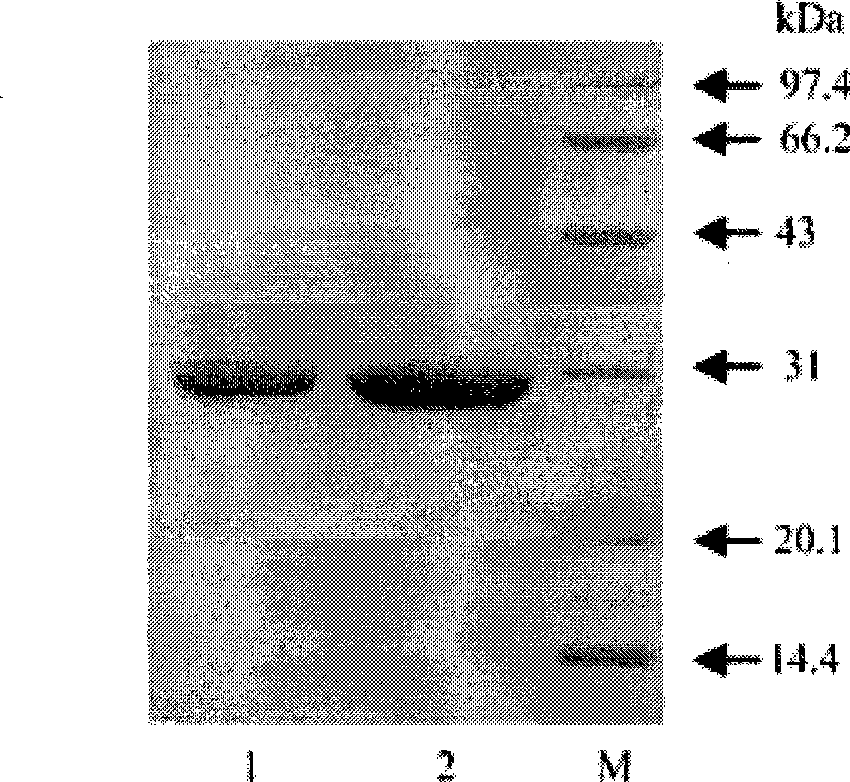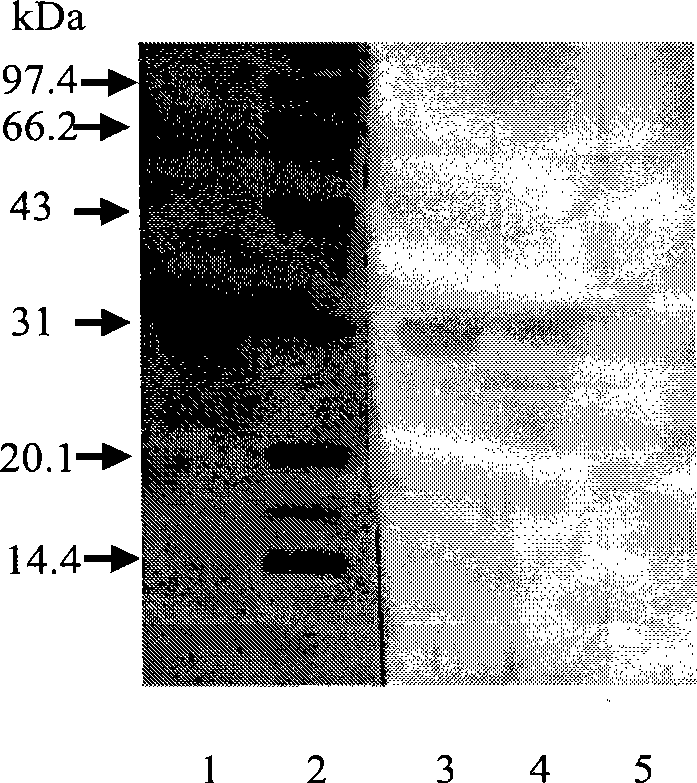Protective antigen composition capable of excitating organism to generate immunity against plague and use thereof
A protective antigen and composition technology, applied in the fields of application, bacterial antigen components, biochemical equipment and methods, etc., can solve the problem that the F1 antigen cannot represent the full virulence of Yersinia pestis
- Summary
- Abstract
- Description
- Claims
- Application Information
AI Technical Summary
Problems solved by technology
Method used
Image
Examples
Embodiment 1
[0048] Example 1. Preparation of untagged rV270 antigenic protein using pET28a and thrombin Xa factor
[0049] 1. Primer design
[0050] According to the nucleotide sequence of Yersinia pestis LcrV gene, design and synthesize a pair of oligonucleotide primers with factor Xa restriction site, the upstream primer is: 5-CGCG GATCC ATCGAAGGTCGTATGATTAGAGCCTACGAAC (the underlined part is the BamHI restriction site, the italicized part is the Xa factor restriction site, sequence 2 in the sequence table); the downstream primer is: 5-CCGGCC AAGCTT TTAGGCAAAGTGAGATAATTC (the underlined part is the HindIII restriction site, sequence 3 in the sequence listing).
[0051] 2. Amplification of rV270 gene
[0052] Use Yersinia pestis DNA (20ng) as template, 1 μl of upstream and downstream primers (5 μM) in step 1, 3 μl of dNTP (10 μM), 3 μl of 10×buffer, 0.2 μl of Taq DNA polymerase (5U / μl), add sterile deionized water to a total volume of 30 μl. The amplification conditions were: pre-d...
Embodiment 2
[0066] Example 2, Utilizing pET28a and enterokinase to prepare untagged rV270 antigenic protein
[0067] 1. Primer design
[0068] According to the nucleotide sequence of Yersinia pestis LcrV gene, design and synthesize a pair of oligonucleotide primers with enterokinase restriction site, the upstream primer is: 5-CGG GGTACC GACGACGACGACAAGATGATTAGAGCCTACGAAC (the underlined part is the Kpn I restriction site, the italic bold part is the enterokinase restriction site, sequence 4 in the sequence table); the downstream primer is: 5-CG GAATTC TTAGGCAAAGTGAGATAATTC (the underlined part is the restriction site of EcoR I, sequence 5 in the sequence listing).
[0069] 2. Amplification of rV270 gene
[0070] Use Yersinia pestis DNA (20ng) as template, 1 μl of upstream and downstream primers (5 μM) in step 1, 3 μl of dNTP (10 μM), 3 μl of 10×buffer, 0.2 μl of Taq DNA polymerase (5U / μl), add sterile deionized water to a total volume of 30 μl. The amplification conditions were: pre...
Embodiment 3
[0084] Example 3: Determination of Antibody Titers and Evaluation of Protective Effects of Mice Immunized with the Protective Antigen Composition of the Present Invention that Can Stimulate the Body's Immunity to Plague
[0085] 1. Extraction and purification of natural F1 antigen of Yersinia pestis EV76 vaccine strain
[0086] Taking the Yersinia pestis EV76 vaccine strain as an example, the following method is used to extract and purify the natural F1 antigen from the Yersinia pestis EV76 vaccine strain, including the following steps:
[0087] 1. Cultivation of Yersinia pestis EV76 vaccine strain
[0088] The Yersinia pestis EV76 vaccine strain (purchased from Lanzhou Institute of Biological Products) was inoculated into 5 mL of heart-brain infusion medium (purchased from BD Company, dissolve 37g of medium in 1L of pure water), culture at 37°C (35-40°C is acceptable) for 24h, then take 300μl of bacterial liquid, and then inoculate into 2L with 0.2% (0.1-0.3% is acceptable) ...
PUM
| Property | Measurement | Unit |
|---|---|---|
| molecular weight | aaaaa | aaaaa |
Abstract
Description
Claims
Application Information
 Login to View More
Login to View More - R&D
- Intellectual Property
- Life Sciences
- Materials
- Tech Scout
- Unparalleled Data Quality
- Higher Quality Content
- 60% Fewer Hallucinations
Browse by: Latest US Patents, China's latest patents, Technical Efficacy Thesaurus, Application Domain, Technology Topic, Popular Technical Reports.
© 2025 PatSnap. All rights reserved.Legal|Privacy policy|Modern Slavery Act Transparency Statement|Sitemap|About US| Contact US: help@patsnap.com



